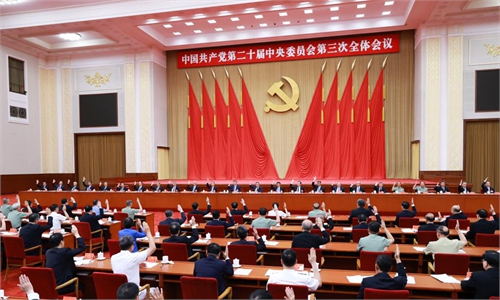
Illustration: Xia Qing/GT
Several Western media outlets have recently published articles exaggerating the impact of China's "falling births" on the country's overall economy.A biased and distorted judgment of China's population development reflects those Western elites' serious lack of understanding of the Chinese economy.
In the process of industrialization, the development of personal awareness, the pursuit of a high-quality life and women's increased participation in the economy have always led to a decline in fertility rates. China isn't immune to this. China's demographic situation is a natural outcome driven by the nation's economic and social development. This phenomenon is quite common. There is no need to exaggerate its influence.
China's population conforms to the laws of social development while keeping its own characteristics.
First, even if China's total population declines in the coming decades, the country's population will still be large.
China is the world's largest developing country, with a population of 1.4 billion. China's population is about four times that of the US.
When industrialization reaches a certain stage, the population development situation will probably change and the fertility rate may decline. However, demographers predict that China's total population will still exceed 1.3 billion in 2050.
Second, with increasing urbanization, more people are seeking jobs in more developed urban areas. As a result, labor resources are abundant in China.
This has created several virtuous cycles: Urbanization is creating better-paid jobs in China's third- and fourth-tier cities, broadening employment channels and relieving employment pressure in big cities. In the meantime, urbanization allows the integration of farmers into urban life, encouraging them to find jobs in secondary and tertiary industries.
This means that China has adequate labor resources to support the development of its manufacturing and services sectors. For instance, China's migrant workers in large number have unique identities: They are both farmers and workers, shuttling back and forth between cities and rural areas. This increases the flexibility of China's labor supply and helps mitigate the impact of population fluctuations on the economy.
Third, while China is making steady progress in scientific and technological innovation, it is also actively developing its educational system to improve the quality of labor, which means the country's demographic dividend will persist.
When assessing a country's demographic dividend, we need to look at not just the size but also the quality of its population. Size does matters, but what matters more is the quality.
In recent years, China has ramped up its efforts to promote the balanced development of compulsory education, increase the coverage of higher education, and strengthen vocational education, aiming to cultivate more specialized talent for emerging high-tech industries, which is in line with the country's economic transformation.
China has emerged as a major driver of global innovation. The development of emerging industries and high-end manufacturing have significantly increased the demand for skilled workers and high-tech talent.
As China pursues industry upgrades for high-quality development, its technological innovation is propelling societal transformation in various ways. Efforts have been made to improve the overall quality of the population, so that China's economy can be advanced with support from the high-quality development of the population.
In this process, China's demographic dividend has not been dwindling. What's more, an upgraded version of demographic dividend that is compatible with high-quality economic development has been in the making in the country.
Of course, it may not be all smooth sailing ahead. China's utilization of the demographic dividend does not mean ignoring the risks of a declining birth rate and an aging population. Efforts to address existing risks are part of China's pursuit of the high-quality development of its population, and the country has done many things in this regard.
The author is a reporter with the Global Times. bizopinion@globaltimes.com.cn



